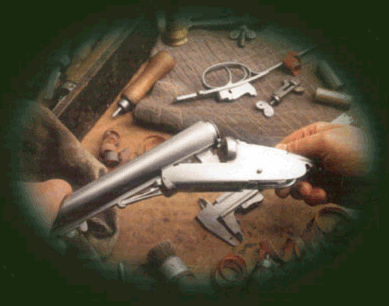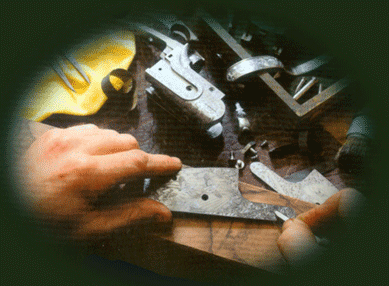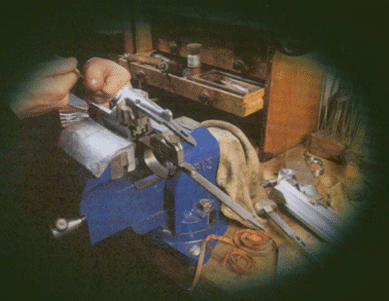Lock, Stock and Barrel – The Making of a Charles Boswell Shotgun

It was in late September 2008, at Griffin & Howe’s Hudson Farm, that the idea of a “family tree” for a Boswell Shotgun first came about.
Irwin Greenstein, Publisher of Shotgun Life, had been handling the 28-gauge bespoke Boswell we had on display for the Game Conservancy USA’s Showcase and Sporting Clays Invitational fundraiser. He was really quite taken with it, and we began talking about how the Boswells are made. I had acquired the records and goodwill of the Charles Boswell Gunmaker Company in January 2004 with the explicit goal of reviving one of Britain’s finest gunmakers.
When you own a company that makes only six shotguns a year with prices that start at nearly $40,000, I am often asked the question of why a bespoke gun is so expensive. The answer is simple: it is more than a gun; it is a piece of art, functional art. It can be admired for its craftsmanship and superlative fit and finish, the beauty of its wood and intricate engraving. But first and foremost it is a gun, but not any ordinary gun but one built by hand, by time served craftsmen, in the same tradition as their grandfathers.
Twelve-hundred hours of skilled hands removing everything of wood and steel that is superfluous to its purpose, so that all that remains is the “Best” gun that can be made. The gun created is unique, there will never be another like it, and the hundreds of man hours give it a liveliness and dynamic handling that a machine made gun could never hope to match.
As Irwin and I continued talking, we thought it would be helpful if people understood the level of time and craftsmanship that goes into each and every Boswell. As you’ll see in a moment, the Boswells of today are made in nearly the identical fashion as the original Boswells of nearly 140 years ago.
Charles Boswell was the son of a butcher, born in December 1850 in the village of Hertford, North of London. A passion for shooting and a keen interest in guns led to him entering servitude, to become a gunmaker at the age of 14. He began with Mr. Thomas Gooch, a traditional gunmaker in the village of Hertford, and from there he progressed to employment in the Royal Small Arms factory in Enfield. On completion of his apprenticeship, he married and opened his own business in Edmonton, with repairs and gun fittings constituting the majority of his early work.
Boswell was a competitive live pigeon shot of some considerable talent and his frequent wins at Hendon Shooting grounds and Hornsey Wood soon brought him to the attention of his fellow trap shooters. By the mid 1870’s, he had developed a substantial business in the fitting and making of custom pigeon guns. Preferring to use the tried and tested patents of other manufacturers, he established a reputation for building guns of quality and reliability. As a result of the popularity of his guns, many were sent abroad.
In June, 1883, he moved to the address with which he is most associated -126 The Strand, London WCI. With custom fitting and building live pigeon guns his specialty, it is little surprise that the recession following the First World War and the banning of live pigeon shooting greatly affected his business.
The live pigeon gun was Charles Boswell’s trademark gun, and there are many spectacular examples still put to good use today. It was Boswell’s tradition of making superbly reliable, perfectly balanced, good-looking competition guns that made me decide to resurrect the name and to begin the manufacture of Boswell guns in January of 2004.
Today, the company Charles Boswell Gunmaker produces what I believe are some of the most exquisite small-bore game guns and the finest bespoke competition shotguns available anywhere. Beyond the coincidence of having the same initials as Charles Boswell, we both strive for the same high level of individual fit and unparalleled craftsmanship. We would hope that Mr. Boswell would have approved of the new extension of his traditional gunmaking skills.
Taking a step in that direction, the 2005 “People’s Choice” winner was the Charles Boswell 28-gauge over-and-under, pinless round action, sidelock ejector, with 29-inch demi block barrels, choked modified and improved modified, weighing 5lb and l2oz, featuring full, deep relief. Our Boswells continue to receive accolades from the media and owners thanks to the diligence of the craftsmen who make up the Boswell family tree.
To produce a Best London Shotgun takes approximately
1,200 skilled hours by time-served craftsmen
Stage One: Action – Locks – Barrels 480 Hours
Machine Body – Make Locks – Make and Join Tubes – File Action – Time Ejectors
Submit to Definitive London Proof

Lee Butler started out with an apprenticeship with Westley Richards before becoming E.J. Churchill workshop foreman in 1999. He is now making guns under his own name and carries out action work for many ‘Best Gun”makers.
Mark Sullivan started his apprenticeship with Holland & Holland as an actioner and ejector worker, before leaving the factory to oversee a specialized team of outworkers that makes guns for Asprey, William and Son and other ‘Best London” makers.
Mick Kelly started his apprenticeship with James Purdey and Sons as a barrel maker before leaving to become the ‘Barrel Maker of Choice’ to the World’s finest gunmakers.
Strike Up Furniture and Iron Work – Then Head Up Stock and Forend
Make Off to Client’s Dimensions

Bobby Smith started out with an apprenticeship with James Purdey and Son as a stocker and is now considered one of the premiere stockers to the London Gun trade.
Andy Marshall served his apprenticeship with James Purdey and Son, an accomplished stocker of a superlative standard.
Dress Off Screws and Pins – Polish for Engraving – Engrave

Keith Thomas started out with an apprenticeship with Holland & Holland in 1964, and as a hand engraver stayed with them for 11 years in all. He then moved to the country and started working freelance for the “Best” gun makers in London, Birmingham and Germany, including Boss & Co, W W Greener, Hartmann & Weiss, Asprey’s, Peter V Nelson, Watson Bros., A A Brown and others. Over the years, he has extended his work to include the patterns and house styles of many different makers from the past and the present day.
Dave Tallet needs little introduction, both he and his sons started out with an apprenticeship with James Purdey and Son and between them have engraved guns for the majority of the London Gun trade
Il Bulino Italy owned by master engraver Diego Bonzi has created some of the most fantastic game scenes and deep double relief scroll, specializing in fantasy engraving.
Colour Case Harden – Regulate – Fully Finish to Include Case and Accessories


Dave Sinnerton in recent years has been making guns under his own name, but he originally trained at James Purdey and Son and is regarded as perhaps the premier finisher to the British gun trade.
Gerry Swanson trained with James Purdey and Son as a finisher, followed by many years with Rigby and is a superlative craftsman.
Richard St. Ledger needs little introduction, and the firm of Ray St. Ledger, rightly famous for their colour case hardening, is acknowledged as the finest in the world for this work.
Ian Tomlin, is the Owner and Director of TEG (Traditional English Guncases), acknowledged as the premier makers of the finest traditional cases and accessories, the only choice for a case in which to properly present a ‘Best Gun’ to its new owner.
Our Boswell shotguns are available in both side-by-side and over-and-under configurations, in any gauge and double rifles will be available in all calibers. Prices start at $39,500.00.
For more information about the Boswell Best Shotguns, please visit http://www.chrisbatha.com/gunsales.html
Please send your comments to letters@shotgunlife.com.

Chris Batha is considered to be one the highest qualified Shooting Instructors in the world today. He has more than 30 years experience coaching, wingshooting and competition clays shooting and a life-long passion for fine guns. Mr. Batha conducts Shooting Schools at some of the finest Shooting Facilities in The United States as well as in Great Britain and Europe, averaging 18 different locations each year. He also organizes instructional and recreational wingshooting trips to the finest destinations in Europe, Africa, South America and the USA. He is a frequent contributor to leading magazines and is author off the highly acclaimed book “Breaking Clays – Target Tactics, Tips & Techniques.” He is also featured in the DVDs “Take Your Best Shot” and “Mastering the Double Gun” by Sunrise Productions. For more information about Mr. Batha, please visit his web site at http://www.chrisbatha.com.


Comments